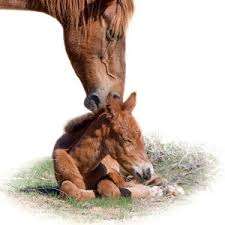Foaling season is just around the corner and owners need to be getting ready.
“A few simple precautions can help most mares produce a healthy, vigorous foal,” said Dr. Thomas R. Lenz.
While some mares have already foaled, most will foal in April and May, affirmed the semi-retired Louisburg equine veterinarian.
Now is the time to select a foaling location, begin assembling necessary supplies and chart a plan of action. “A foal must ingest colostrum within eight to 12 hours of birth to acquire protection against disease,” Lenz explained.
In the final month of gestation, a mare concentrates antibodies in her milk. But she can only produce antibodies against viruses and bacteria either through vaccination or her environment.
“So it is so important to vaccinate a pregnant mare against tetanus, sleeping sickness and other infectious diseases,” Lenz said.
She should be moved to the foaling location 30 days prior to foaling in order to produce disease antibodies.
Foaling on pasture is more natural, generally more hygienic and roomier. “It’s good to have a grass-covered paddock with a light to check on the mare’s foaling progress easier,” Lenz advised.
If the decision is to foal indoors, the mare should be provided a clean 14-feet-by-14-feet disinfected, ventilated stall.
Bacteria encountered by a newborn foal in a dirty, poorly ventilated stall can override antibodies received in the mare’s colostrum. High-quality, dust-free straw is the preferred bedding.
“Most mares will foal at night when activity around the barn is minimal,” Lenz verified. “It’s best to have a dim light near the stall to observe the mare without bothering her. Have your veterinarian’s phone number handy in case of a problem.”
Foaling supplies should include a flashlight, tail wrap, clean bucket, towels, and a watch to record stages of labor. “Iodine is required for disinfecting the foal’s navel as well as a sodium enema for the new born,” Lenz said. “Mild soap is needed to wash the mare’s vulva and hindquarters.”
It is important to have an alternate source of colostrum available from veterinary supply sources.
“Healthy normal foals will begin to breathe immediately following birth,” Lenz explained. “They will rest on their sternum before attempting to stand within 30 minutes and usually nurse within two hours.”
The mare will usually rest on her chest following delivery and then slowly rise and begin nuzzling the foal.
“If the mare appears agitated or aggressive toward the foal, restrain her and consult your veterinarian for advice,” Lenz said. “A single kick from an aggressive mare can seriously injure or kill a newborn foal.”
Once the mare stands, the placenta is usually passed within a few minutes to a couple of hours. “If the mare is stepping on the placenta, tie it up on itself with a piece of twine,” Lenz said. “Under no circumstance should the placenta be cut off or pulled out.
“If the placenta is retained for more than three hours, notify your veterinarian,” Lenz insisted. “A retained piece of placenta can cause serious uterine infection and prevent rebreeding.”
Within about an hour, the mare should be alert, allowing the foal to nurse and looking for something to eat. “Allow the mare to eat and drink as soon as she is ready,” Lenz said.
The mare’s temperature should be recorded every six to eight hours for the first 24 hours after delivery. Temperature which can be taken with a rectal thermometer ranges from 99.5 F to 101.5 F.
“An elevated temperature can indicate an infection, while decreased temperature might mean a serious blood loss,” Lenz said.
It’s also a good idea to check the foal’s temperature which should range from 99.5 F to101.5 F. “Temperatures higher than 103 F indicate a serious disorder,” Lenz warned.
“As a general rule of thumb, I conduct a mare-foal examination within eight to 12 hours of foaling,” Lenz said. “I check that the mare has not experienced severe trauma to her birth canal and is producing plenty of milk.
“I also examine the placenta to ensure that it is normal in appearance and has been completely expelled,” Lenz continued. “The foal is examined to ensure that all body systems are working and verify that the navel is drying up.”
According to the veterinarian, a foal should pass the meconium, the first sticky, dark stool, within 12 hours of birth. “If this does not occur or if the foal appears to be straining, a mild enema may be administered,” Lenz suggested.
“Finally, encourage the mare and foal to rest and give them plenty of opportunity to bond,” Dr. Lenz advised.
CUTLINES
The birth of a foal is one of the most wondrous events a horse owner can experience, according to Dr. Thomas R. Lenz. Good preparation will allow enjoyment to the fullest, he insisted.
Now semi-retired at Louisburg, Dr. Thomas R. Lenz served a most notable lifetime career in equine veterinary medicine





